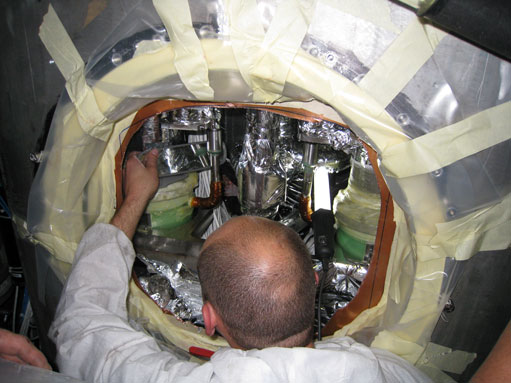
ATLAS e-News
23 February 2011
End Cap Toroid goes under the knife
22 July 2008

A technician examines the faulty electrical isolater, two metal tubes with green resin between
The ATLAS detector has thousands of tiny parts that could become its Achilles heel if they fail. One system in which a small but crucial piece lays the whole detector low is the toroid magnet system that puts the T in ATLAS.
When tested last autumn, both End Cap Toroids were working to order, but when spring tests rolled around, a major leak appeared in the system that circulates the liquid helium to cool the side A End Cap to superconducting temperatures. Herman Ten Kate, the Magnet Project leader, and his team had limited time to diagnose and fix the problem.
Their number one suspect was the electrical isolators. These pieces make sure that a junction exists between two metal parts which stops electrical conduction but allows the helium to pass through. These pieces have to withstand rapid cooling from almost room temperature to that of the liquid helium as well as reheating. “Every magnet engineer knows this is a very vulnerable part, these electrical isolators,” says Herman.
The isolator was designed so that one steel tube fitted inside another with epoxy resin in between as an insulating seal. They surmised that the inner tube had pulled away from the resin, during a fast cool-down, enough to allow the helium to leak out. Of course these parts were thoroughly tested before installation but repeated exposure to thermal shocks caused this one to fail. However, these parts were inside the turret, a small tower protruding from the top of the magnet, through which all cooling tubes from the ECT pass.
To further complicate matters, the magnet was already in place. It needed three weeks of warming up to room temperature, starting on June 5th, before they could access it, but the team wasted no time. They asked the CERN machine shop to quickly develop a tool that would carefully cut a hole in the turret, over half a metre wide. Although they already had a good idea of the nature of the problem, they ordered parts for every other possible repair so that waiting for parts wouldn’t cost them another two weeks.
The cutting tool was prepared by the time the magnet was warm, a rotating disk with two milling heads, scraping away just one millimetre per turn. Starting Saturday, June 21st, the team cut with surgical precision for 5 days, from about six in the morning to six in the evening, to get through the 50-millimetre-thick aluminium casing.
The actual leak search and confirmation took only a couple of hours on Wednesday, June 25th. They placed a plastic bag over the junction between the two electrically isolated tubes and turned the system on, watching the bag inflate. A “Helium-sniffer” confirmed that the leaked gas was indeed helium.
“We were, in a way, very lucky,” Herman admits. “This part was already suspicious. We opened the vessel, and it’s the suspicious part that was leaking.” If the leak had not been in the turret, it could have taken many months to locate and repair.
They cut away the old, resin-based electrical isolator and installed a new ceramic cryogenic electrical isolator. The piece itself may be a mere eight centimetres long, but its complete failure could have brought the magnet – with a diameter of 11 metres and depth of five – to its knees.
However, the leak is repaired, and the access hole in the turret was closed with a large flange that resealed the vacuum of the vessel, according to Alexey Dudarev, a magnet engineer on Herman’s team. The side A End Cap Toroid started cooling again on Monday, July 7th, and electrical tests are currently underway.

Katie McAlpineATLAS e-News
|